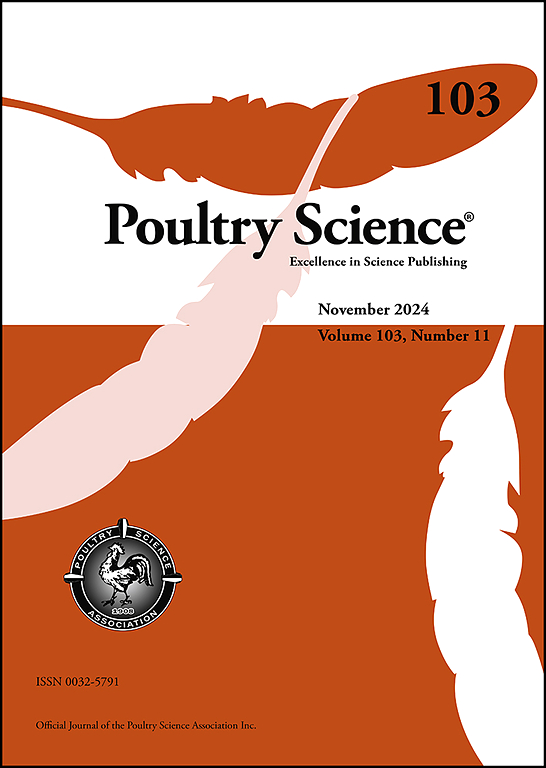结合蛋白质组学和代谢组学来阐明鸡疙瘩蛋产生的调控机制:疙瘩蛋形成机制的多组学分析。
IF 3.8
1区 农林科学
Q1 AGRICULTURE, DAIRY & ANIMAL SCIENCE
引用次数: 0
摘要
蛋壳不仅能保护鸡蛋不受外界破坏,而且也是影响消费者选择的关键因素,仅次于价格。在产蛋后期,蛋疙瘩发生率显著增加,严重影响蛋的孵化性和食品安全。本研究比较了产痘痘蛋的母鸡和产正常蛋的母鸡子宫蛋白质组和代谢组的差异,旨在确定可能在痘痘蛋形成中起关键作用的蛋白质和代谢物。子宫组织中共鉴定出242个差异表达蛋白(DEPs),其中116个表达上调,126个表达下调。富集分析显示,DEPs在与离子转运、能量代谢和免疫应答相关的途径中富集。研究发现,在正常蛋组(NE)中,HCO₃⁻主要通过SLC4A1运输,尽管其他运输途径也可能起作用。相反,在扁蛋组(PE)中,碳酸氢盐离子(HCO₃⁻)主要通过SLC4A4传递。此外,子宫内共鉴定出44种差异代谢物(DMs), PE组5′-腺苷酸(ATP)显著下调。形成蛋壳所需的离子和基质蛋白从子宫细胞沿浓度梯度向子宫液输送,这一过程需要消耗大量的能量。PE组ATP浓度的降低可能是影响卵泡形成的重要因素。随后,我们发现DEPs和DMs在多个信号通路中共同富集,包括与能量代谢相关的FoxO信号通路、与烟酸和烟酰胺代谢相关的FoxO信号通路以及与免疫应答相关的色氨酸代谢。值得注意的是,PE组中参与这些信号通路的DMs均下调。我们的研究结果表明,SLC4A1、SLC4A2和ATP2B4 (DEPs)以及5'-腺苷酸和葫芦巴碱(DMs)通过与能量代谢、离子转运和免疫反应相关的机制影响蛋壳的形成。这些dep和DMs可作为蛋壳品质遗传改良的潜在生物标记物。本文章由计算机程序翻译,如有差异,请以英文原文为准。
Integrating proteomics and metabolomics to elucidate the regulatory mechanisms of pimpled egg production in chickens
Eggshells not only protect the contents of the egg from external damage but are also a key factor influencing consumer choice, second only to price. In the later stages of egg production, the incidence of pimpled eggs significantly increases, severely affecting the hatchability and food safety of the eggs. This study compares the differences in the uterine proteomes and metabolomes of hens producing pimpled eggs and those producing normal eggs, aiming to identify the proteins and metabolites that may play a crucial role in the formation of pimpled eggs. A total of 242 differentially expressed proteins (DEPs) were identified in uterine tissue, of which 116 were upregulated and 126 were downregulated. Enrichment analysis revealed that the DEPs were enriched in pathways related to ion transport, energy metabolism, and immune responses. The study found that in the normal eggs (NE) group, HCO₃⁻ was predominantly transported via SLC4A1, although other transport pathways may also play a role. In contrast, in the pimpled eggs (PE) group, bicarbonate ions (HCO₃⁻) was primarily transported through SLC4A4. Additionally, a total of 44 differentially metabolites (DMs) were identified in the uterus, with 5′-Adenylic acid (ATP) being significantly downregulated in the PE group. The ions and matrix proteins required for eggshell formation are transported from uterine cells to the uterine fluid against a concentration gradient, a process that consumes a substantial amount of energy. The decrease in ATP concentration in the PE group may be a significant factor influencing the formation of pimpled eggs. Subsequently, we found that the DEPs and DMs were jointly enriched in several signaling pathways, including the FoxO signaling pathway related to energy metabolism, nicotinate and nicotinamide metabolism, and tryptophan metabolism associated with immune response. Notably, the DMs involved in these signaling pathways were all downregulated in the PE group. Our research findings indicate that SLC4A1, SLC4A2, and ATP2B4 (DEPs), along with 5′-adenylic acid and trigonelline (DMs), influence the formation of eggshells through mechanisms related to energy metabolism, ion transport, and immune response. These DEPs and DMs may serve as potential biomarkers for the genetic improvement of eggshell quality.
求助全文
通过发布文献求助,成功后即可免费获取论文全文。
去求助
来源期刊

Poultry Science
农林科学-奶制品与动物科学
CiteScore
7.60
自引率
15.90%
发文量
0
审稿时长
94 days
期刊介绍:
First self-published in 1921, Poultry Science is an internationally renowned monthly journal, known as the authoritative source for a broad range of poultry information and high-caliber research. The journal plays a pivotal role in the dissemination of preeminent poultry-related knowledge across all disciplines. As of January 2020, Poultry Science will become an Open Access journal with no subscription charges, meaning authors who publish here can make their research immediately, permanently, and freely accessible worldwide while retaining copyright to their work. Papers submitted for publication after October 1, 2019 will be published as Open Access papers.
An international journal, Poultry Science publishes original papers, research notes, symposium papers, and reviews of basic science as applied to poultry. This authoritative source of poultry information is consistently ranked by ISI Impact Factor as one of the top 10 agriculture, dairy and animal science journals to deliver high-caliber research. Currently it is the highest-ranked (by Impact Factor and Eigenfactor) journal dedicated to publishing poultry research. Subject areas include breeding, genetics, education, production, management, environment, health, behavior, welfare, immunology, molecular biology, metabolism, nutrition, physiology, reproduction, processing, and products.
 求助内容:
求助内容: 应助结果提醒方式:
应助结果提醒方式:


